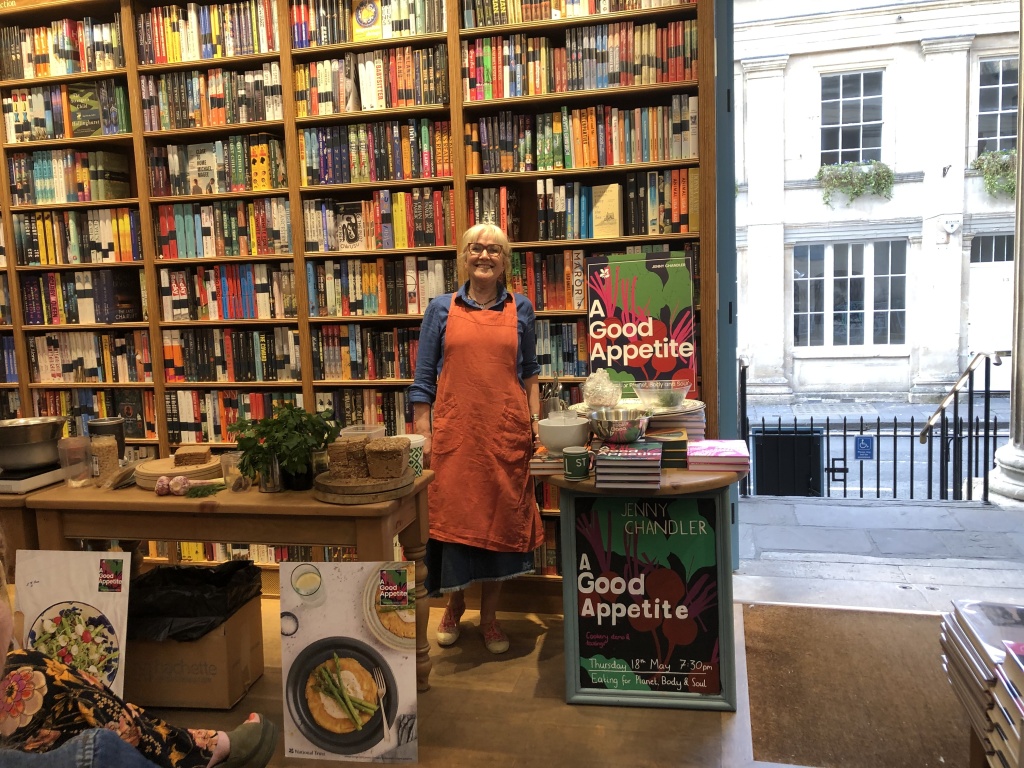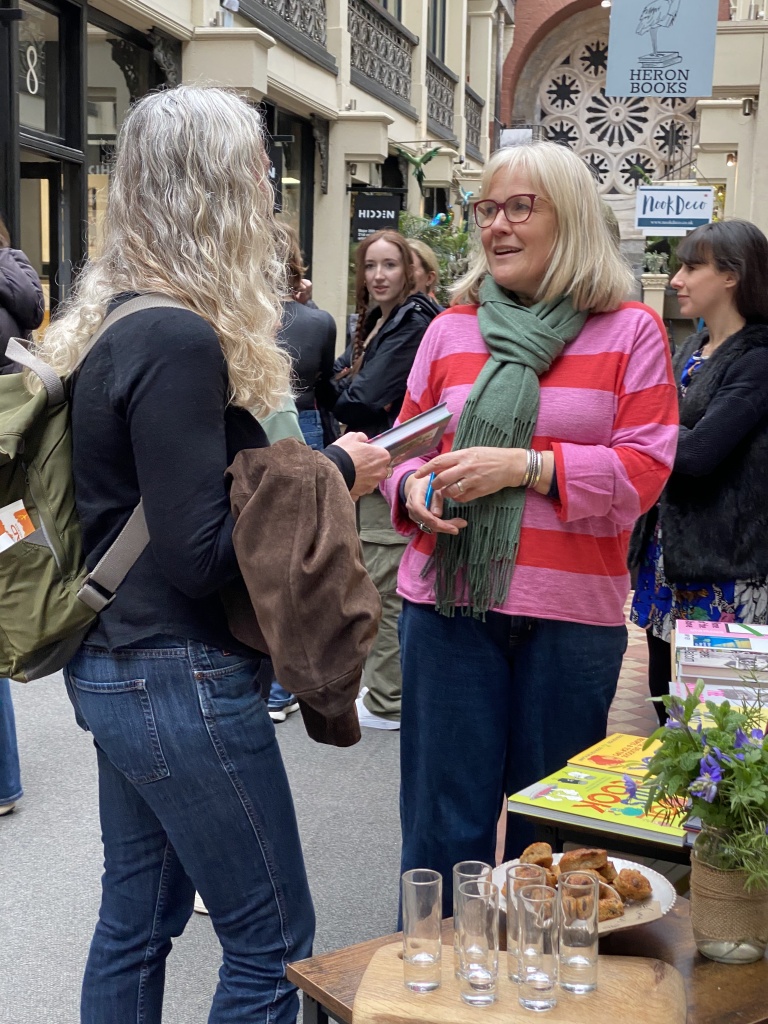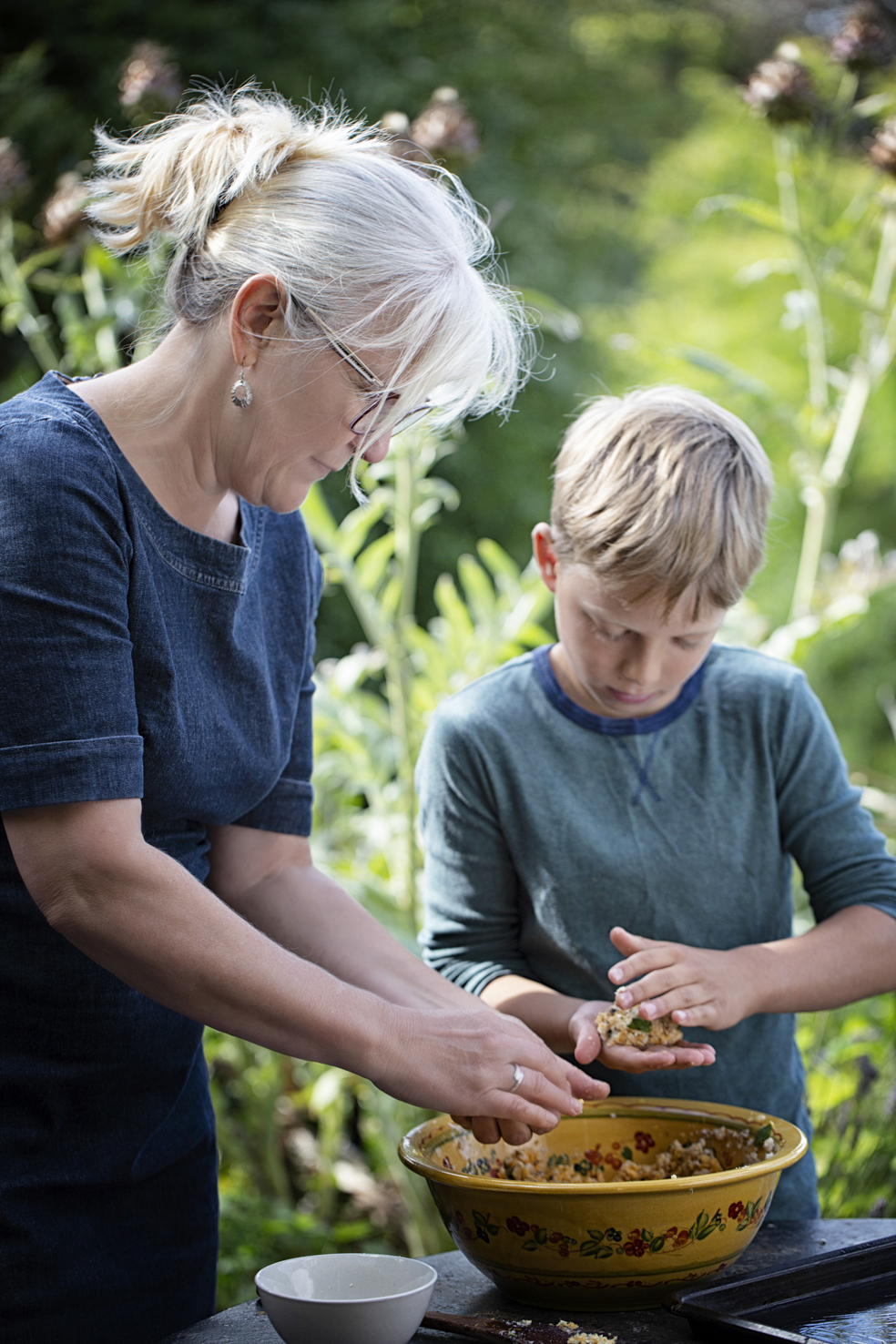My daughter, Imi, is about to leave primary school, it’s the end of an era (breaks my heart if I’m honest), she’s had the most amazing time. So, a couple of days ago Peter and I donned our aprons and performed a ” Fanny and Johnny” cooking demo’ ( I do tend to boss the poor chap around a bit in the kitchen), as a school fundraiser.

We eat less and less meat at home, it just seems a no brainer to me – as a result we eat far more veg’ (including lots of pulses, well of course) which means more nutrients, more fibre and I believe a far more varied and interesting diet. There’s the sustainability side of things too, with meat requiring vast quantities of our valuable resources to produce: we eat just a little meat, see it as an absolute treat and make sure that it is produced ethically.
So back to the evening – all performed in truly unprofessional style on a table that just about reached our knees, with a 2 hob Baby Belling to cook on. I promised the parents that I’d post the recipes, so for the rest of you here are a few bonus dishes. Too busy to take pictures of the food I’m afraid, but here are a couple of snaps of the two of us in action (Peter in full Johnny-mode and me looking like I’ve swallowed my teeth as I gonged my pan to get the show on the road – what an attractive couple we are!)
Zucchini fritters ( makes about 10)
You could make these with grated carrot, parsnip, beetroot, squash. How about adding some spices? you could even just add a ready made spice mix such as a bit of garam masala/ ras al hangout/ baharat and keep the herbs to parsley aand chives (maybe throw in coriander too). This is a truly versatile recipe and a great way to get your kids eating more veg’.
1 onion, diced
1 tbsp olive oil oil
3 cloves garlic, crushed
3 medium courgettes, grated
125 g green pea flour or chickpea flour
1 tsp salt
3 tbsp mixed fresh herbs eg thyme, oregano, parsley, chives, rosemary
1 tbsp pine kernels, sunflower seeds, pumpkin seeds, sesame seeds,
3 tbsp olive oil
Fry the onion until soft in the oil and then add the garlic for a moment or 2.
Now mix all the ingredients together well.
Heat up the oil in a large frying pan and place spoonfuls of the mixture into the hot oil.
Fry in 2 batches. Turning the fritters once golden and set.
Drain on paper towel and keep warm in the oven for a few minutes if not serving straight away.
Romesco Sauce (enough for 12 servings)
A short cut recipe for Romesco, not authentic at all ( if you’re after the real thing then here’s a recipe ) This works beautifully with the fritters, with roasted veg’ (or with a bit of lamb or fish – you see I’m not anti animal protein, its just about eating less of it).
1 red pepper
2 tomatoes
5 cloves of garlic
1 heaped tbsp sweet paprika
1 small dried red chilli pepper
100g hazelnuts, roasted ( or a mix of almonds and hazelnuts)
1 -2 tbsp red wine vinegar
5 tbsp extra virgin olive oil
salt
a handful of parsley, chopped
Pre-heat the oven to 200 C
Roast the pepper in the oven for about 30 minutes adding the tomato and garlic for last 10 minutes.
Place everything in a blender together ( bar the parsley that you can stir in later – otherwise the sauce will turn a murky browny – green), balancing the vinegar, salt and olive oil at the end.
Add the parsley and serve.
Chickpea flat bread – Farinata
Italian farinata, cecina, torta di ceci (depending on where you’re from), or socca from just over the French border in Nice, is a simply baked flatbread made from chickpea flour. The locals love it. Trattorias and bakeries the length of the Riviera draw regular lunchtime queues and back in my Italian yachting days I became a fan too.
The bakery in Chiavari had a sign scrawled up in the window announcing the time the hot farinata was on sale, straight from the wood-fired oven. I remember zipping back to the boatyard on my moped with a meticulously tied greaseproof parcel of steaming farinata for the crew.
A wood-fired oven is obviously not on the cards for most of us but you can create something approximating farinata in a very hot domestic oven. It’s usually just served with plenty of black pepper but I love to pile some delicious cheese or cured meat on the top.
Serves 4
200 g chickpea flour (gram flour, besan)
1/2 tbsp finely chopped rosemary (optional)
1 tsp salt
400 ml water
3 tbsp extra virgin olive oil
plenty of freshly ground black pepper.
Tip the chickpea flour, salt and rosemary into a large bowl and slowly whisk in the water until you have a loose, lump-free batter. Rest the batter for at least an hour and up to 12
Preheat the oven to 220 C/425 F/Gas mark 7
Take a large flat tin or oven-proof frying pan ( the professionals have a huge round pan specifically for the purpose) and heat it up in the oven or on the hob.
Skim off any froth from the top of the batter and then stir in most of the olive oil.
Add the remaining oil to the hot pan, swirling it to create a non stick surface. Now tip in the batter to a depth of about 1 cm/just under 1/2 an inch and place in the oven.
Bake for about 15 to 20 minutes or until the surface of the farinata is crisp and bubbling. I sometimes give mine a quick blast under the grill for some extra colour.
Give it a few turns of the pepper mill, slice up with a pizza cutter and serve right away.
To make unorthodox individual servings:
Fry off the batter (still about a centimetre thick) in a small omelette pan, turning it, just as you would a pancake ( make sure that it is non-stick ….ahem). Once the farinata is set slip it onto a greased oven tray. Repeat the process with the remaining batter, layering greaseproof between each flatbread and then place the tray in the oven for about 5 minutes before serving.
Serve with piles of tomato salad or anything else that takes your fancy.
Syrian-style lentils Serves 6
4 tbsp olive oil
3 brown onions, sliced finely
6 garlic cloves, finely chopped
2 tsp cumin seeds, toasted and then ground
pinch of chilli flakes or better still 2 tsp sweet Aleppo chilli flakes
300 g brown or green lentils
salt and pepper
juice of 1 lemon
bunch of coriander, roughly chopped
Heat the oil in a large saucepan and add the onions. Keep the temperature fairly low and allow the onions to soften, sweeten and turn golden; this may take about 30- 40 minutes. Be patient.
Take out half of the onions from the pan and set aside. Turn up the heat and throw in the garlic, cumin and chilli. Stir and, as soon as you can really smell the garlic, add the lentils and enough water to cover them by about 5 cm/2 inches.
Bring to the boil and then turn down to a simmer. Cover the pan and cook until the lentils soften and begin to break down. You may have to add a little extra water from time to time if they are getting dry but go carefully, remember that you don’t want to drain away any delicious juices later. Once the lentils are really soft, and this can take over an hour, taste and adjust the seasoning with salt, pepper and enough lemon juice to freshen the dish up. Stir in the coriander leaves and garnish with the remaining fried onions.
Roasted carrots –
Preheat oven to 200 ºc
Roast carrots ( smaller carrots that can be served whole or cut lengthways do look good)
Peel carrots if you feel the need , cut into chunks or leave whole if little ones, toss in olive oil and roast for about 30 mins depending on size until tender and browning a little.
Throw in some sesame seeds, cracked coriander seeds for the last 5 minutes.
Serve carrots on top of the lentils with a good splash of pomegranate molasses , maybe some pomegranate seeds, sprouted radishes or herbs – whatever you have.
Labneh recipe coming soon …….. I’ve run out of time!
I’m off to Sicily later tonight, have yet to do my packing and am taking part in the fabulous Bristol Food Connections this afternoon making falafel and minestrone and talking all things British Pules related with the fabulous Nick Saltmarsh of Hodmedods
Thank yous
Massive thanks to Max from Bar Buvette who sorted the magnificent bar.
Anna Byass a Hotwells PTA powerhouse who does soon much behind the scenes and basically made our event happen.
To Kirsty, Kate and all the other fab’ Year 6 parents who cooked, helped and supported the event.

The team.. ..all looking rather shiney faced and hot, we’d been working hard!
Also huge thanks to Leigh Court Farm, Reg The Veg, Chandos Deli, Isle of Wight Tomatoes and the Co-Op for being so generous donating ingredients.
HOORAH – we made lots of money for the fabulous Hotwell’s Primary School , where so many of our children have been given just the best start in life.



























 As many of you know I am fairly obsessed with pulses; just had flat bread, Beluga lentils, tomatoes and z’atar for lunch so I really do practice what I preach. Perhaps my favourite dish of all is dal, by which I mean the soupy, creamy pulse dish topped with its own tailor-made, zippy mix of herbs or spices.
As many of you know I am fairly obsessed with pulses; just had flat bread, Beluga lentils, tomatoes and z’atar for lunch so I really do practice what I preach. Perhaps my favourite dish of all is dal, by which I mean the soupy, creamy pulse dish topped with its own tailor-made, zippy mix of herbs or spices.










